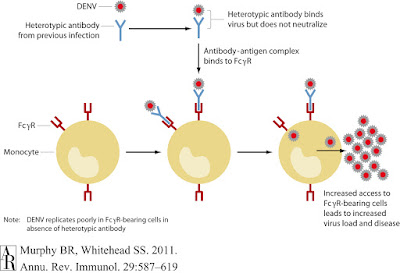Malarial TRAP family proteins
were thought to function during cell invasion, with the merozoite form MTRAP involved
in asexual erythrocytic infection. However, a recent study of gene disruption
using knockouts and the CRISPR-Cas9 system reveal unexpected roles for the
MTRAP protein in cell egress and gamete development.
The TRAP (thrombospondin-related
anonymous protein) family are conserved in various apicomplexan parasites causing
severe human disease, including malaria (Plasmodium
spp), and toxoplasmosis (Toxoplasma spp). Previous research
studying the TRAP protein family had suggested functions during cell invasion
and gliding motility 2. Whilst this may hold true for some of the
protein family members, research undertaken by Bargieri et al 1 has revealed the merozoite TRAP protein (MTRAP)
operates in an unexpected way.
Using gene knockouts in the malaria animal model Plasmodium berghei, and the CRISPR-Cas9 system in human Plasmodium falciparum, the research suggests that MTRAP deficiency results in a transmission block. Without MTRAP, neither male nor female gametocytes are able to egress from erythrocytes in the mosquito, which prevents zygote formation and further transmission. It had been thought MTRAP was expressed in the Plasmodium asexual merozoite, responsible for the erythrocytic cycle, where it mediated adhesion and invasion of the red blood cell. This theory was primarily based on previous research suggesting MTRAP localised in the merozoite apical microneme organelles, interacting with the parasite invasion machinery. However this work had been unable to present evidence of MTRAP binding directly to erythrocytes2, 5, which is now explained by the findings of Bargieri et al.
In P. berghei, the authors first noticed inability to express MTRAP showed
no effect on asexual blood stage parasite growth. When investigating this
finding in both wildtype and knockout Plasmodium
spp, immunofluorescence assays using polyclonal antibodies identified MTRAP
expression at higher levels in the sexual gametocyte stages. Using fluorescent protein
expression in gametocytes revealed that MTRAP deficiency correlated with non-formation
of ookinetes or oocysts in the mosquito midgut – and unexpectedly that MTRAP
has a role in the sexual stages of the malaria lifecycle.
Testing the applications of this
research involved moving from an animal model to the human species malaria Plasmodium falciparum. Using the
CRISPR-Cas9 system to disrupt the MTRAP locus showed no change in blood stage
parasitaemia, with MTRAP expression instead being strongly detected in gametes
unable to rupture the parasitophorous vacuole membrane.
In wild type parasites, exflagellation of the male
macrogamete occurs inside the erythrocytic parasitophorous vacuole. Before
egress from the erythrocyte, the vacuole is ruptured and male gametes form
exflagellation centres on the inner red blood cell membrane. Activated MTRAPKO
gametes were found to form motile
flagella but did not form exflagellation centres in either P. berghei or P. falciparum.
Microscopy of gamete activation found the knockouts remained inside the parasitophorous
vacuole, and the authors believe this stems from an inability to disrupt the
vacuole membrane. Further evidence was
given to this theory by complementing defective mutants with an episomally
expressed MTRAP, which resulted in partial restoration of the parasite sexual
cycle.
Emerging resistance to commonly
used antimalarial compounds and insecticides pose a risk to malaria control
efforts, and there is not yet an efficacious commercially available vaccine 4,
5. Although this
research does not suggest MTRAP as a candidate for vaccines blocking
erythrocytic invasion, the protein could be explored to block transmission. Further
research into MTRAP’s role in parasitophorous vacuole disruption and gamete
egress is needed to understand its potential role in a vaccine. It may be that
MTRAP does indeed have roles in parasite actin motors and motility, although in
a different stage to the parasite lifecycle than previously expected. Whilst
further work still needs to be performed exploring MTRAP function, this
research clearly demonstrates the remarkable utility of the CRISPR-Cas9 system
in malaria.
References
- Bargieri, D.Y. et al. Plasmodium Merozoite TRAP Family Protein Is Essential For Vacuole Membrane Disruption and Gamete Egress From Erythrocytes. Cell Host & Microbe 20, 619-630 (2016).
- Baum, J. et al. A conserved molecula motor drives cell invasion and gliding motility across malaria life cycle stages and other apicomplexan parasites. Journal of Biological Chemistry 281, 5197-5208 (2006).
- Kehrer, J., Frischknecht, F. and Mair, G. R. Proteomic analysis of the Plasmodium berghei gametocyte egressosome and vesicular bilD of osmiophilic body proteins identifies merozoite TRAP-like protein (MTRAP) as an essential factor for parasite transmission. Molecular and Cellular Proteomics 15, 2852-2862. (2016).
- Outtara, A and Laurens, M.B. Vaccines against malaria. Clinical Infectious Diseases 60, 930-936. (2015).
- Cowman, A.F., Healer, J.m Marapana, D. and Marsh, K. Malaria: Biology and Disease. Cell 167, 610-624. (2016).




